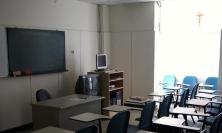
A report released yesterday by Ofsted (the Office for Standards in Education, Children’s Services and Skills) investigates the academic achievement of children from low-income families in the UK. Sandra McNally of the Centre for Economic Performance, London School of Economics and the University of Surrey looks at how current policy affects the educational prospects of children from disadvantaged backgrounds.
A long-standing problem for education in the United Kingdom is the ‘long tail of underachievers’. These are the people who end up leaving school with low qualifications, if any, and become classified as NEET - ‘not in education, employment or training’. While the UK fares well in international comparisons of numbers of high academic achievers, it performs very badly when considering the number of people who leave school with low levels of education and skill.[1] Closely related to this problem is the fact that young people who grow up in relative poverty are much more likely to end up in similar economic circumstances later in life. Addressing these issues is important not only from a social justice perspective but also for the future growth of the country.[2] This article considers whether our education policy helps or hinders the prospects of young people from poor families.
Parents are understandably concerned about getting their children into a ‘good’ school, but the admissions system is frequently criticised for disadvantaging low income families. We will therefore explore firstly how changes to the schools admission system might help poorer families. However, it is also important to raise the performance of schools that are currently further down the distribution, so that parents can be assured of a good education for their child regardless of their choice of school. We will consider the evidence for two proposed strategies to affect this improvement: increasing school expenditure to improve performance; and the push towards transforming schools into academies, and encouraging new groups to set up their own ‘free’ schools.
A fair admissions system?
In principle, the ‘comprehensive’ system of education in England should enable all children to gain access to (roughly) the same standard of education, regardless of the economic circumstances of their family.[3] The comprehensive system was introduced in most of the UK during the 1960s and 1970s, replacing a system where children were selected for different school types on the basis of their performance in tests at the age of 11 (such ‘selection by ability’ still takes place over all of Northern Ireland and in some parts of England). Since the disadvantages of poverty are strongly reflected in test results at 11, the selective system led to a low probability of gaining access to a ‘better’ (grammar) school for a child coming from a low-income family background. For this reason, selection by ability is now prohibited in most state schools in England. Although much fairer than the selective system it replaced, the comprehensive system nonetheless creates its own form of social injustice. When schools are over-subscribed (a common problem for popular schools, especially in urban areas), schools can discriminate between children based on certain criteria. The most common criterion is distance from the school. This means that those families who can afford to live in properties that are near a ‘good school’ (studies for England find that local school quality accounts for about 3% of the average value of a home) have a better chance of getting their child into that school compared with less well-off families who are likely to live further away.
So, even the comprehensive system of education allows better-off families to get a better deal from state education, thus exacerbating inequality in an already-unequal society. One might ask whether faith schools do anything to redress the inequality, since they are allowed to discriminate based on measures of religiosity instead of (or as well as) distance. Faith schools tend to have a wider catchment area but have often been criticised for taking fewer disadvantaged children than might be expected. The data available is insufficient to judge and the evidence is inconclusive; nonetheless, recent research about faith schools in England should give educational leaders cause for concern. Although faith schools do better than other state schools in terms of examination results, the difference in school performance disappears after taking into account the characteristics of young people who attend these schools (e.g socio-economic background, early achievement, whether the school was the parents’ preferred school for their child)[4]. This suggests that the superior academic performance of faith schools has more to do with the profile of their intake than their religious ethos.
If there is a more advantaged intake, this in turn may be for one of two reasons: either the admissions policy is inadvertently discriminating against applicants who come from disadvantaged backgrounds; or people from disadvantaged backgrounds are less likely to be in the pool of applicants at all. These issues are quite different, but both are problematic for a Church that wants to reach out to the poor. Other recent research for England, using a large and detailed longitudinal study of teenagers and their families,[5] shows that parents reporting a religious affiliation are a little more likely to be better educated, have a higher occupational class and a higher household income that those without a religious affiliation. The same study finds that higher-income religious families are more likely to have a child at a faith school than lower-income religious families.[6]
At a local level, it is important that school leaders should look at their admissions policy in the light of concerns about social justice. All voluntary-aided schools (and academies) control their own admissions. They have the ability to look at how their rules might impinge on local communities, making changes where necessary.[7] In the longer term, another way to level the playing field is to improve the quality of schools lower down the distribution.
School expenditure
Raising school expenditure seems, on the face of it, to be an obvious way to improve school quality. Government policy and the state of the economy do not currently allow for increases to public spending, but it is notable that schools have been relatively well-protected compared with other areas of expenditure. The ‘pupil premium’ policy (involving a more direct connection between government funding and the number of disadvantaged pupils in a school) also gives rise to some redistribution of resources between schools. Should we expect an increase in the budget of schools with more disadvantaged pupils to improve the performance of these pupils?
The efficacy of school resources is strongly contested within the academic literature. It is difficult to observe a relationship between expenditure and academic achievement at face value because school expenditure is only one driver of change in school performance, and often it is negatively correlated with other factors.[8] For example, children from disadvantaged backgrounds often do worse in their exams because of less favourable circumstances at home. If schools with more such children have an increased budget, one would expect to see a negative correlation between trends in expenditure and pupil achievement. This is a difficult problem for researchers trying to establish a causal relationship between changes in expenditure and pupil achievement. However, as data quality and research methods improve, more studies tend to find positive effects of school expenditure on pupil achievement.[9] For example, a recent study for primary schools in England[10] suggests that an additional £1,000 per student paid to schools in urban areas (close to Local Authority borders) raises student test scores at the end of primary school (at Key Stage 2).[11] Also, the study finds that effects of expenditure are greater in schools with more disadvantaged students. This is a general trend in the literature - increases in resourcing are usually, though not universally, found to be more effective in disadvantaged schools and/or for disadvantaged students at all phases of education. This suggests that disadvantaged students are more responsive to resource-based interventions, implying that it is more efficient (as well as equitable) to target resources at these students.[12]
The main point to take from this discussion is that school resources do matter for educational attainment, especially for poorer students. There is good evidence then that the strategy to protect the schools budget and redistribute resources towards schools with more disadvantaged pupils (through policies like the pupil premium policy) is effective.
Academies and Free Schools
The creation of academies and free schools is the latest (and quite dramatic) change in government policy to try to improve schools by changing the institutional environment in which they operate. ‘Academies’ are run by their sponsors and board of governors. They have responsibility for employing all staff (including negotiating pay and conditions), and freedom over most of the curriculum (except for core subjects) and all aspects of school organisation. This is a big change for most schools, as the Local Authority traditionally had a big influence on many aspects of decision-making and teachers’ pay has been monitored by national pay agreements. This policy was originally devised for a limited number of schools in disadvantaged areas (about 200 under New Labour), but has recently been expanded to cover many times that number (currently over 2,000) and no longer applies specifically to schools in disadvantaged areas.
It is much too early to evaluate the expansion of this policy. However, there have been efforts to evaluate the effects for the original schools that became academies up to 2009/10. There are three main findings from the most detailed and rigorous study. [13] Firstly, schools that became academies started to attract higher-ability students. Secondly, there was an improvement in performance at GCSE exams, even after accounting for the change in student composition. Thirdly, neighbouring schools started to perform better, too. This might be because they were exposed to more competition, or it might reflect the sharing of academy school facilities (and expertise) with the wider community. However, another recent study has investigated the beneficiaries of this original policy.[14] It found that the benefits were entirely concentrated among students of medium-high prior attainment (as measured by attainment at the end of primary school). The policy did nothing to improve the performance students at the lower end of the ability distribution. Since students from disadvantaged families are more likely to be found in this low-ability group, one might infer that the policy was not particularly effective for improving the attainment of disadvantaged students.
We will not know the effects of the expanded academies policy for a few years. However, current evidence does not give reason to think it will be particularly beneficial for low-ability students, many of whom are from economically disadvantaged backgrounds. Furthermore, since published performance tables measure average performance rather than performance at the lower end of the ability distribution, schools do not have strong incentives (aside from social justice concerns) to focus their efforts on children whose performance will not improve the outside perception of the school.
A more positive aspect of recent reforms is the opportunity for new ‘free’ schools to be formed by interested groups, who have a lot of freedom over how such a school will be run and are able to focus explicitly on the needs of particular neighbourhoods. There have been a couple of recent, top-quality academic studies showing how such schools have brought about radical transformation of the education of children from poor families in the US. One of these was about a type of charter school in Boston[15] and another was about the ‘Harlem Children’s Zone’ in New York[16]. These schools provided a range of services not typically provided in schools (e.g., a much longer school day, extensive after-school tutoring). These were big, costly changes and cannot be generalised to contexts where policy change is far more incremental. However, they show that it is not a foregone conclusion that children who start life in difficult circumstances need replicate the poor circumstances of their families (in terms of education and income). They are encouraging demonstration of the difference that schools can make to the lives of disadvantaged young people, and perhaps they will inspire others to follow their example in this country.
Dr Sandra McNally is a Professor of Economics at the University of Surrey and a Research Associate at the Centre for Economic Performance, London School of Economics.
[1] See, for example, discussion in Hansen, K. and Vignoles, A., ‘The United Kingdom Education System in Comparative Context’ in S. Machin and A. Vignoles (eds), What’s the Good of Education? (Princeton University Press, 2005).
[2] See, for example, the LSE Growth Commission report: http://www2.lse.ac.uk/researchAndExpertise/units/growthCommission/documents/pdf/LSEGC-Report.pdf
[3] Comprehensive education means that children of all abilities are educated in the same schools and have the opportunity to undertake exams for the same qualifications. In England, about 93% of children attend such schools (mainly financed by government expenditure; no fees).
[4] Gibbons, S. and Silva, O., ‘Faith Primary Schools: Better Schools or Better Pupils?’, Journal of Labor Economics, 29(3): 589-635, July 2011.
[5] Allen, R. and West, A., ‘Why do faith secondary schools have advantaged intakes? The relative importance of neighbourhood characteristics, social background and religious identification amongst parents’, British Educational Research Journal, 37(4): 691-712, 2011.
[6] Comparing the top income quartile with lower income groups, the statistics are 52% versus 47% for Catholic families; 9% versus 8% for Church of England families.
[7] It is possible to devise over-subscription criteria that do not depend so much on distance to the school – for example, banding and lotteries. With regard to measures of religiosity, principals and governors should be aware that parents from higher social class backgrounds may be better able to negotiate the admissions process and understand how to meet specific admissions criteria (suggested by Allen and West, 2011). In this case, the simpler the process and the criteria, the less discriminatory it will be in terms of social class.
[8] Also, most variation in performance between pupils is driven by family background, parental inputs, natural student abilities and random variation – and not by factors that vary between schools.
[9] We will be publishing a detailed literature review shortly on our website: http://cep.lse.ac.uk/_new/publications/prog.asp?resprog
[10] Gibbons, S., S. McNally and M. Viarengo, ‘Does Additional Spending Help Urban Schools? An Evaluation Using Boundary Discontinuities?’ (CEE Discussion Paper. No. 128. London School of Economics, 2011).
[11] The effect is equivalent to moving 19% of students currently achieving Level 4 in Maths (the target grade) to Level 5 (the top grade) and 31% of students currently at Level 3 Maths to Level 4. The magnitude of these effects is consistent with the middle range in the school resources literature, and high enough to pass an approximate cost-benefit test.
[12] However, it is possible that this phenomenon sometimes arises because the potential gains at the top end of the distribution are limited by the design of many school testing systems.
[13] Machin, S., and J. Vernoit, ‘Changing School Autonomy: Academy Schools and Their Introduction to England’s Education’ (CEE Discussion Paper. No. 123. London School of Economics, 2011).
[14] Machin, S., and O. Silva, (2013), ‘School Structure, School Autonomy and the Tail’ (CEP Special Report:
http://cep.lse.ac.uk/pubs/download/special/cepsp29.pdf).
[15} Abdukadiroglu, A., J. D. Angrist, S.M. Dynarksi, T.J. Kane and P. Parthak, ‘Accountability and Flexibility in Public Schools: Evidence from Boston’s Charters and Pilots’ Quarterly Journal of Economics 126(2): 699-748, 2011.
[16] Fryer, R., and W. Dobbie, ‘Are High-Quality Schools Enough to Increase Achievement Among the Poor? Evidence from the Harlem Children’s Zone’, American Economic Journal: Applied Economics 3(3): 158-187, 2011.
![]() Ofsted report: Unseen children: access and achievement 20 years on
Ofsted report: Unseen children: access and achievement 20 years on





